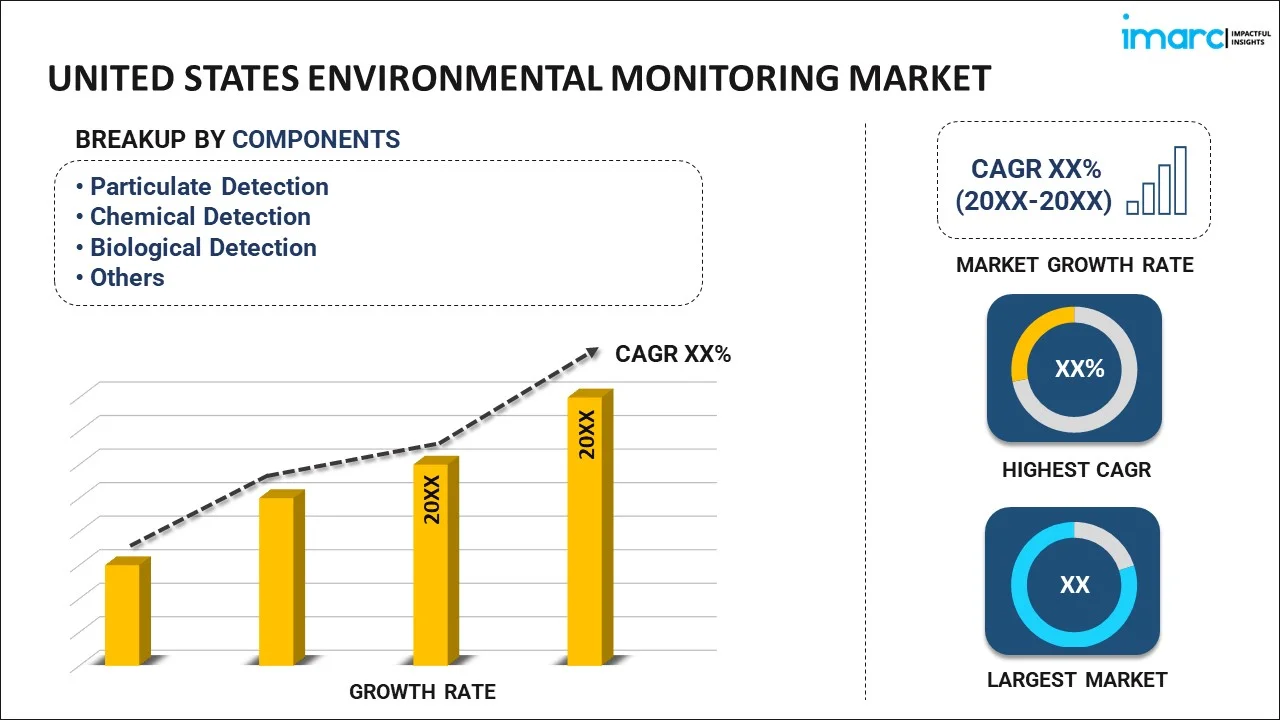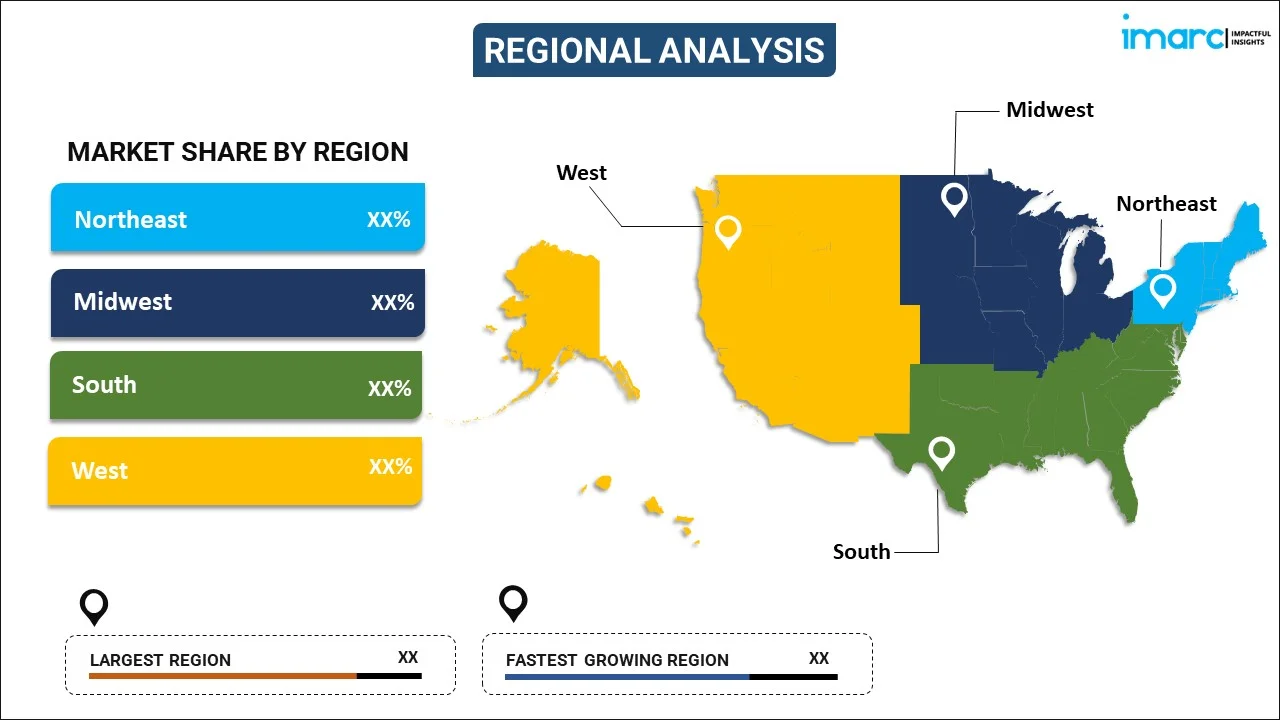
United States Environmental Monitoring Market Report by Component (Particulate Detection, Chemical Detection, Biological Detection, Temperature Sensing, Moisture Detection, Noise Measurement), Product Type (Environmental Monitoring Sensors, Environmental Monitors, Environmental Monitoring Software, Wearable Environmental Monitors), Sampling Method (Continuous Monitoring, Active Monitoring, Passive Monitoring, Intermittent Monitoring), Application (Air Pollution Monitoring, Water Pollution Monitoring, Soil Pollution Monitoring, Noise Pollution Monitoring), and Region 2025-2033
Market Overview:
United States environmental monitoring market size reached USD 5.4 Billion in 2024. Looking forward, IMARC Group expects the market to reach USD 9.7 Billion by 2033, exhibiting a growth rate (CAGR) of 6.7% during 2025-2033. The widespread adoption of cutting-edge technologies to address complex environmental challenges and the launch of favorable policies by government bodies to promote responsible resource management are primarily driving the market growth across the country.
|
Report Attribute
|
Key Statistics
|
|---|---|
|
Base Year
|
2024
|
|
Forecast Years
|
2025-2033
|
|
Historical Years
|
2019-2024
|
|
Market Size in 2024
|
USD 5.4 Billion |
|
Market Forecast in 2033
|
USD 9.7 Billion |
| Market Growth Rate 2025-2033 | 6.7% |
United States Environmental Monitoring Market Analysis:
- Major Market Drivers: The escalating need for regulatory compliance across industries drives substantial demand for environmental monitoring solutions. Government mandates for emissions tracking, water quality assessment, and soil contamination monitoring compel organizations to invest in Advanced monitoring technologies. Additionally, increasing public awareness regarding environmental health impacts accelerates market adoption.
- Key Market Trends: Advanced sensor technologies and IoT integration are transforming traditional monitoring approaches, enabling real-time data collection and analysis. Cloud-based monitoring platforms facilitate remote access to environmental data, enhancing decision-making capabilities. The United States environmental monitoring market analysis reveals growing emphasis on predictive analytics and artificial intelligence applications in environmental assessment.
- Competitive Landscape: The market features a mix of established technology companies and specialized environmental monitoring firms competing through innovation and service excellence. Competition centers around technological advancement, product reliability, and comprehensive service offerings. Strategic partnerships between technology providers and environmental consultancies are becoming increasingly prevalent.
- Challenges and Opportunities: High initial investment costs and technical complexity present significant adoption barriers for smaller organizations. However, expanding regulatory requirements and growing environmental consciousness create substantial growth opportunities. The integration of emerging technologies like blockchain for data integrity offers promising avenues for market expansion.
Environmental monitoring encompasses the application of diverse tools and methodologies to evaluate the consequences of activities on the environment. Central to this process is a data management hub, incorporating features like compliance checking validation, automated environmental monitoring alerts, and stringent quality control measures. This multifaceted approach plays a critical role in safeguarding public water supplies, overseeing the handling of hazardous and radioactive waste, and pinpointing sources of pollution. Beyond these functions, environmental monitoring allocates resources for effective land planning and economic development, aids in the protection of endangered species, mitigates risks, and upholds human health standards. As such, the practice of environmental monitoring aids in ensuring responsible and sustainable practices across various industries and sectors.
United States Environmental Monitoring Market Trends:
Integration of Artificial Intelligence and Machine Learning Technologies
United States environmental monitoring market share is going through immense change with the integration of artificial intelligence and machine learning (ML) algorithms in order to improve data processing and predictive analytics. These technologies allow automated pattern detection in environmental data, thereby enabling early pollution event detection and environmental anomalies. Advanced AI technologies are able to manage huge volumes of sensor information from various sources at the same time and present detailed environmental analyses with enhanced precision and minimal human error. Machine learning algorithms are being used ever more frequently to forecast air quality changes, water pollution incidents, and climate-driven environmental alterations. This integration of technology increases the effectiveness of monitoring activities at lower operational expenses, broadening access to environmental monitoring for more organizations and government agencies.
Growth in Remote and Satellite-Based Monitoring Systems
Remote sensing technologies and satellite-based environmental monitoring systems are unprecedentedly gaining momentum in the United States environmental monitoring market growth, significantly changing the way environmental information is gathered over large geographical extents. These systems offer real-time monitoring on a continuous basis without the need for physical presence at sites of monitoring, minimizing operation costs and enhancing data coverage. Advanced satellite sensors are capable of detecting different environmental parameters such as air quality, water quality, deforestation, and land use changes with high accuracy. The technology allows for monitoring of remote or risky locations that would be hard or risky to access using conventional methods. Government institutions and ecological associations are increasingly using these solutions for mass environmental monitoring, climate observations, and emergency response processes, causing remarkable growth in the market for this category.
Portable and Wearable Environmental Monitoring Devices
The use of portable and wearable environmental monitoring devices is a major trend in the United States market, meeting personal environmental consciousness and occupational safety needs. These miniature devices are capable of tracking several different parameters such as air quality, radiation, noise pollution, and exposure to chemicals in real time and offering instant feedback to the user. Miniaturization of advanced sensors has made it possible for developing complex monitoring abilities in devices that are small enough to be carried or worn on the body. These solutions prove especially useful for industrial workers, field researchers, and individuals concerned with their own personal exposure to the environment. The inclusion of wireless connectivity enables these devices to feed data into wider environmental monitoring networks, which can generate overarching environmental awareness systems that can have direct benefits for individual users and environmental research programs more widely.
United States Environmental Monitoring Market Segmentation:
IMARC Group provides an analysis of the key trends in each segment of the market, along with forecasts at the country level for 2025-2033. Our report has categorized the market based on component, product type, sampling method, and application.
Component Insights:

To get more information on this market, Request Sample
- Particulate Detection
- Chemical Detection
- Biological Detection
- Temperature Sensing
- Moisture Detection
- Noise Measurement
The report has provided a detailed breakup and analysis of the market based on the component. This includes particulate detection, chemical detection, biological detection, temperature sensing, moisture detection, and noise measurement.
Product Type Insights:
- Environmental Monitoring Sensors
- Environmental Monitors
- Environmental Monitoring Software
- Wearable Environmental Monitors
A detailed breakup and analysis of the market based on the product type have also been provided in the report. This includes environmental monitoring sensors, environmental monitors, environmental monitoring software, and wearable environmental monitors.
Sampling Method Insights:
- Continuous Monitoring
- Active Monitoring
- Passive Monitoring
- Intermittent Monitoring
The report has provided a detailed breakup and analysis of the market based on the sampling method. This includes continuous monitoring, active monitoring, passive monitoring, and intermittent monitoring.
Application Insights:
- Air Pollution Monitoring
- Water Pollution Monitoring
- Soil Pollution Monitoring
- Noise Pollution Monitoring
A detailed breakup and analysis of the market based on the application have also been provided in the report. This includes air pollution monitoring, water pollution monitoring, soil pollution monitoring, and noise pollution monitoring.
Regional Insights:

- Northeast
- Midwest
- South
- West
The report has also provided a comprehensive analysis of all the major regional markets, which include Northeast, Midwest, South, and West.
Competitive Landscape:
The market research report has also provided a comprehensive analysis of the competitive landscape. Competitive analysis such as market structure, key player positioning, top winning strategies, competitive dashboard, and company evaluation quadrant has been covered in the report. Also, detailed profiles of all major companies have been provided.
Recent News and Developments:
- February 2024: NASA launched its PACE satellite aboard a SpaceX Falcon 9 rocket, introducing advanced ocean and atmosphere monitoring capabilities. The Plankton, Aerosol, Cloud, ocean Ecosystem mission enables comprehensive environmental monitoring through hyperspectral imaging technology, supporting climate research and ocean health assessment initiatives globally.
- March 2024: Emerson introduced the Rosemount 3490 Controller for level and flow measurement in water and wastewater applications. Designed with simplified configuration and intuitive usability, it enhances sustainability, optimizes operational efficiency, and ensures regulatory compliance, supporting reliable process management in industrial and municipal environments.
- August 2024: Honeywell launched an advanced emissions monitoring system specifically designed for offshore oil and gas operations. The real-time monitoring technology enhances environmental compliance capabilities while supporting sustainable operational practices in challenging marine environments, addressing critical industry needs for accurate emissions tracking.
United States Environmental Monitoring Market Report Coverage:
| Report Features | Details |
|---|---|
| Base Year of the Analysis | 2024 |
| Historical Period | 2019-2024 |
| Forecast Period | 2025-2033 |
| Units | Billion USD |
| Scope of the Report | Exploration of Historical and Forecast Trends, Industry Catalysts and Challenges, Segment-Wise Historical and Predictive Market Assessment:
|
| Components Covered | Particulate Detection, Chemical Detection, Biological Detection, Temperature Sensing, Moisture Detection, Noise Measurement |
| Product Types Covered | Environmental Monitoring Sensors, Environmental Monitors, Environmental Monitoring Software, Wearable Environmental Monitors |
| Sampling Methods Covered | Continuous Monitoring, Active Monitoring, Passive Monitoring, Intermittent Monitoring |
| Applications Covered | Air Pollution Monitoring, Water Pollution Monitoring, Soil Pollution Monitoring, Noise Pollution Monitoring |
| Regions Covered | Northeast, Midwest, South, West |
| Customization Scope | 10% Free Customization |
| Post-Sale Analyst Support | 10-12 Weeks |
| Delivery Format | PDF and Excel through Email (We can also provide the editable version of the report in PPT/Word format on special request) |
Key Benefits for Stakeholders:
- IMARC’s industry report offers a comprehensive quantitative analysis of various market segments, historical and current market trends, market forecasts, and dynamics of the United States environmental monitoring market from 2019-2033.
- The research report provides the latest information on the market drivers, challenges, and opportunities in the United States environmental monitoring market.
- Porter's five forces analysis assist stakeholders in assessing the impact of new entrants, competitive rivalry, supplier power, buyer power, and the threat of substitution. It helps stakeholders to analyze the level of competition within the United States environmental monitoring industry and its attractiveness.
- Competitive landscape allows stakeholders to understand their competitive environment and provides an insight into the current positions of key players in the market.
Key Questions Answered in This Report
The environmental monitoring market in the United States was valued at USD 5.4 Billion in 2024.
The United States environmental monitoring market is projected to exhibit a CAGR of 6.7% during 2025-2033, reaching a value of USD 9.7 Billion by 2033.
The widespread adoption of cutting-edge technologies to address complex environmental challenges, favorable government policies promoting responsible resource management, increasing regulatory compliance requirements, and growing public awareness regarding environmental health impacts are the primary drivers of market growth.
Need more help?
- Speak to our experienced analysts for insights on the current market scenarios.
- Include additional segments and countries to customize the report as per your requirement.
- Gain an unparalleled competitive advantage in your domain by understanding how to utilize the report and positively impacting your operations and revenue.
- For further assistance, please connect with our analysts.
 Request Customization
Request Customization
 Speak to an Analyst
Speak to an Analyst
 Request Brochure
Request Brochure
 Inquire Before Buying
Inquire Before Buying




.webp)




.webp)












